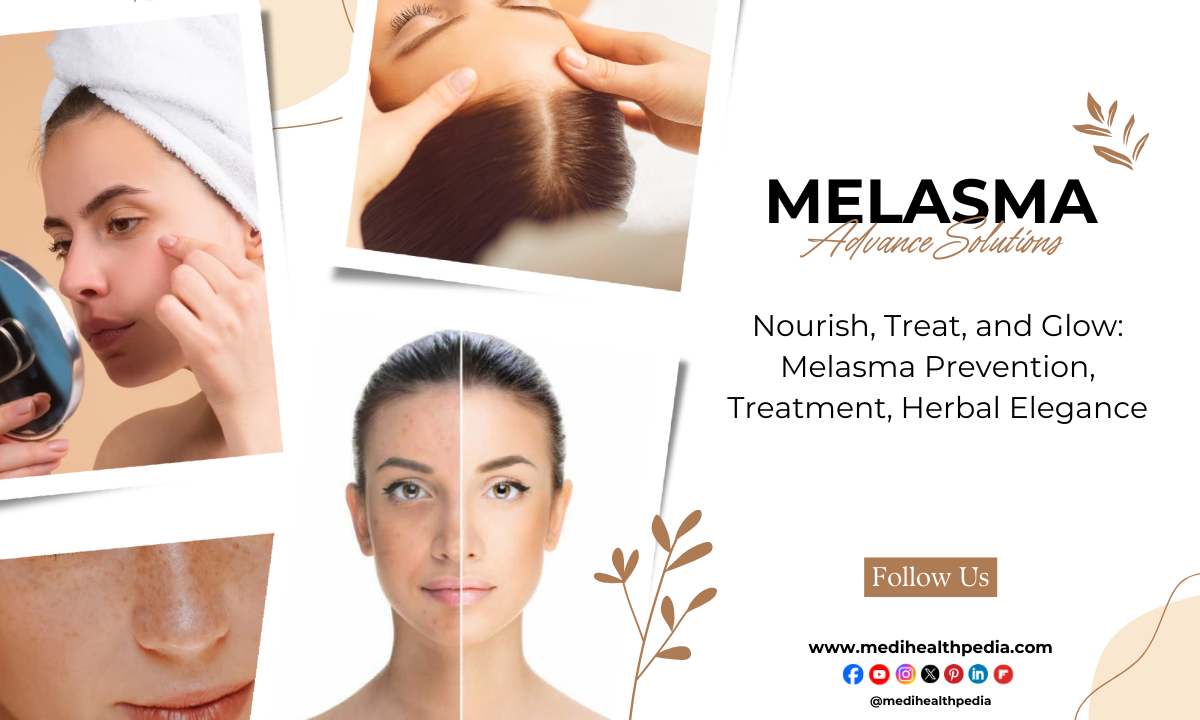Unlocking the Secrets of Melasma: An All-Inclusive Guide to Undertaking, Treating, and Preventing Skin Discoloration
Introduction
Melasma, often referred to as the “mask of pregnancy,” is a common skin condition that affects many individuals, particularly women. Characterized by brown or grayish-brown patches on the face, melasma can have a significant impact on self-esteem and quality of life. In this comprehensive article, we will delve into the world of melasma, exploring its overview, presentation, differential diagnosis, conventional treatment guidelines, prevention, herbal medicines for treatment, lifestyle modifications, and conclude with a summary of key takeaways to help you better understand and manage this condition.

Overview
What is Melasma?
Melasma is a skin disorder characterized by the development of dark, irregular patches on the face, typically on the cheeks, forehead, bridge of the nose, and upper lip. It can also appear on other sun-exposed areas of the body, such as the neck and forearms. This condition is more common in women, particularly those with darker skin tones, but it can affect people of all ethnic backgrounds.
Causes and Triggers
The exact cause of melasma is not entirely understood, but it is thought to involve a combination of genetic, hormonal, and environmental factors. Some common triggers and risk factors include:
- Hormonal Changes: Hormonal fluctuations, such as those that occur during pregnancy, menopause, or while taking birth control pills, can stimulate the overproduction of melanin, the pigment responsible for skin color.
- Sun Exposure: Ultraviolet (UV) radiation from the sun can worsen existing melasma and trigger its development. UV rays stimulate the production of melanin in the skin.
- Genetics: A family history of melasma may increase the likelihood of developing the condition.
- Cosmetic Products: Certain cosmetics and skincare products, particularly those that irritate the skin, can exacerbate melasma.
Presentation
Melasma typically presents as brown to gray-brown patches on the face. These patches can vary in size and shape and often have a symmetrical distribution. The condition is categorized into three main types:
- Epidermal Melasma: This type of melasma affects the top layer of skin (epidermis) and appears as light brown patches.
- Dermal Melasma: Dermal melasma affects the deeper layers of the skin (dermis) and presents as grayish or bluish patches.
- Mixed Melasma: Mixed melasma is a combination of both epidermal and dermal involvement and is the most common type.
Differential Diagnosis
Melasma shares some similarities with other skin conditions, and a differential diagnosis is crucial for proper treatment. Conditions to consider include:
- Post-Inflammatory Hyperpigmentation (PIH): PIH can occur after skin inflammation, such as acne or an injury, and result in dark spots similar in appearance to melasma.
- Solar Lentigines: Also known as liver spots or age spots, these are small, dark areas of the skin caused by sun exposure.
- Freckles: Freckles are small, light brown spots that can resemble early-stage melasma but are usually genetic in origin and darken with sun exposure.
- Seborrheic Dermatitis: This skin condition can lead to red or scaly patches, but in some cases, it may be confused with melasma.
- Café-au-Lait Spots: These are flat, light brown birthmarks that can sometimes be mistaken for melasma.
If you suspect you have melasma or a related condition, it is important to consult a dermatologist for an accurate diagnosis.
Conventional Treatment Guidelines
While melasma can be challenging to treat, several conventional treatment options are available. It’s important to note that results can vary, and some treatments may take weeks or even months to show improvement. Here are some of the standard treatment guidelines for melasma:
- Sun Protection: The most crucial step in managing melasma is sun protection. Use broad-spectrum sunscreen with an SPF of 30 or higher daily, even on cloudy days. Wear protective clothing, sunglasses, and wide-brimmed hats when outdoors.
- Topical Treatments:
- Hydroquinone: This skin-lightening agent is available by prescription or over-the-counter and can help fade dark patches over time. It should be used under the guidance of a healthcare professional.
- Tretinoin and Corticosteroids: These medications are sometimes combined with hydroquinone for enhanced results.
- Azelaic Acid: An acid found in grains like barley and rye, azelaic acid is available in prescription creams and can help improve the appearance of melasma.
- Chemical Peels: Chemical peels involve applying a chemical solution to the skin, which causes it to peel and eventually reveals new, lighter skin. This treatment is typically done in a dermatologist’s office.
- Laser Therapy: Certain laser and light-based therapies, such as intense pulsed light (IPL) and fractional lasers, can target melanin in the skin and help reduce the appearance of melasma.
- Microneedling: Microneedling involves creating tiny micro-injuries in the skin to stimulate collagen production and improve skin texture. It can be combined with topical treatments for melasma.
- Oral Medications: In some cases, dermatologists may prescribe oral medications, such as tranexamic acid or certain antioxidants, to address melasma from within the body.
It’s important to note that individual responses to these treatments may vary, and some individuals may require a combination of therapies to achieve the best results. Consulting with a dermatologist is crucial to determine the most suitable treatment plan for your specific case.
Prevention
Preventing melasma is more straightforward than treating it, and protecting your skin from potential triggers can go a long way in maintaining healthy, even-toned skin. Here are some effective prevention strategies:
- Sun Protection: Sunscreen is your best defense against melasma. Choose a broad-spectrum sunscreen with SPF 30 or higher and apply it daily, even on cloudy days. Reapply every two hours when outdoors.
- Protective Clothing: Wear long-sleeved shirts, wide-brimmed hats, and sunglasses to shield your skin from UV rays.
- Avoid Hormonal Triggers: If you are prone to melasma, discuss hormone-related medications with your healthcare provider. They may recommend alternative contraception methods or hormone therapy options.
- Gentle Skincare: Avoid using harsh skincare products that can irritate the skin and exacerbate melasma. Opt for gentle, hypoallergenic products.
- Regular Check-ups: If you have a family history of melasma, consider regular check-ups with a dermatologist to monitor your skin and detect any signs of melasma early on.
Herbal Medicines
In addition to conventional treatments, some individuals seek herbal and natural remedies to address melasma. It’s important to note that while these remedies are generally considered safe, they may not be as effective as prescription treatments, and results can vary widely. Here are some herbal medicines and natural treatments that are often explored for melasma:
- Aloe Vera: Aloe vera gel is known for its soothing properties and may help reduce the appearance of melasma. Apply a thin layer of aloe vera gel to the affected areas and leave it on for 20-30 minutes before rinsing.
- Turmeric: Turmeric has anti-inflammatory and skin-lightening properties. You can create a paste by mixing turmeric with milk or yogurt and apply it to the affected areas. Leave it on for 15-20 minutes before rinsing.
- Licorice Root Extract: Licorice root contains a compound called glabridin, which may help reduce pigmentation. Look for skincare products containing licorice root extract or apply it topically.
- Vitamin C: Topical vitamin C serums are known for their antioxidant properties and may help brighten the skin. Look for serums with a high concentration of vitamin C.
- Milk and Honey: A mixture of milk and honey can be applied to the affected areas for 15-20 minutes before rinsing. Both ingredients have skin-nourishing properties.
- Glycolic Acid: Glycolic acid, derived from sugarcane, is known for its exfoliating properties. It can help remove dead skin cells and improve skin texture. Look for glycolic acid-based products.
It’s important to consult with a dermatologist before using herbal remedies to ensure they are safe and appropriate for your skin type. Remember that results can vary, and herbal remedies should not replace sun protection and prescribed treatments for melasma.
Lifestyle Modification
In addition to medical and herbal treatments, certain lifestyle modifications can help manage melasma and improve skin health:
- Diet: A balanced diet rich in antioxidants and skin-friendly nutrients can contribute to overall skin health. Consider incorporating foods like fruits, vegetables, and fish into your diet.
- Stress Management: High stress levels can exacerbate melasma. Engage in stress-reduction techniques such as yoga, meditation, or deep breathing exercises.
- Sleep: Ensure you get enough quality sleep as it plays a vital role in skin repair and rejuvenation.
- Avoid Triggers: Identify and avoid any triggers that worsen your melasma, whether it’s certain skincare products, excessive sun exposure, or hormonal factors.
- Skincare Routine: Develop a consistent and gentle skincare routine that includes cleansing, moisturizing, and sun protection.
Conclusion
Melasma is a common skin condition that affects many individuals, predominantly women. It can be challenging to manage, but with the right approach, you can significantly improve the appearance of your skin. Key takeaways from this comprehensive guide on melasma include:
- Melasma is a skin disorder characterized by brown or grayish-brown patches on the face.
- The exact causes of melasma are not entirely understood but involve hormonal, genetic, and environmental factors.
- Differential diagnosis is essential to rule out other skin conditions.
- Conventional treatments include sun protection, topical therapies, chemical peels, laser therapy, and oral medications, but results can vary.
- Prevention through sun protection and avoiding hormonal triggers is crucial.
- Herbal remedies and natural treatments are often explored, but their efficacy may vary.
- Lifestyle modifications can contribute to overall skin health and help manage melasma.
If you suspect you have melasma or are seeking treatment, consult a dermatologist for a personalized approach to managing this condition. With the right combination of treatments, prevention, and lifestyle modifications, you can take control of melasma and achieve healthier, more radiant skin.
